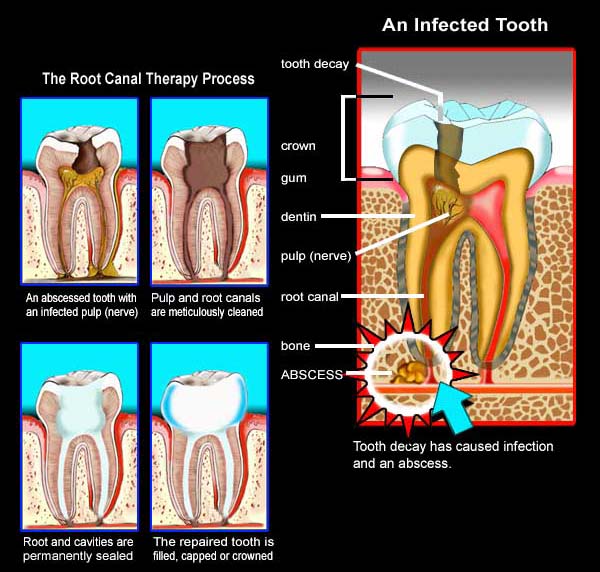Root canal treatment (endodontics) is about saving teeth, rather than removing them. In the past, the only way to treat teeth with disease was to pull them. This is not the case today. Now, thanks to modern dental techniques, we are able to save damaged teeth more than 90% of the time.
Root canal therapy treats disorders in the nerve (pulp) of the tooth. It can save a tooth whose pulp, which contains its nerves and blood supply, is diseased or damaged. Pulp disease usually means that the tooth will be lost unless something is done to save it. Root canal therapy involves replacing the diseased pulp with a substance that will keep the tooth functional.

Reasons for Root Canals
A damaged or diseased tooth will not heal by itself. Without treatment, the infection will spread, bone around the tooth will begin to degenerate and the tooth could fall out. The only alternative is removing the tooth.
Common Factors and Symptoms
- Trauma such as physical blow
- Irritation caused by deep decay
- Advanced gum disease
- Pain or throbbing while biting
- Sensitivity to hot and cold
- Severe decay or an injury that creates inflammation
Treatment
After examining and x-raying the tooth, it will be determined if a root canal is needed. When the decision for root canal therapy has been made, a series of appointments will be scheduled.
- First appointment – the diseased pulp will be removed, leaving the canal intact. The canal will be rinsed out, and a medication will be placed inside the canal. A temporary crown will be placed on the tooth.
- Second appointment – the canal will be sterilized and filled with a permanent material. It’s important to follow all of your instructions to avoid complications.
Over the years, people have heard horror stories about root canals. Rest assured that your dentist will administer medication to make sure the area is numb and you won’t feel pain. Today, a root canal procedure using modern technology is nearly pain-free. The tissue surrounding the tooth may be sensitive following the procedure. Over-the-counter pain medication can be used to help the discomfort.
After Care
After the root canal is completed, you may notice a slight discoloration and brittleness in the treated tooth. In most cases, your dentist will recommend that the treated tooth receive a permanent crown. If the tooth is not crowned, you may want to ask your dentist about tooth whitening. A follow-up exam can monitor tissue healing. From this point on, brush and floss as usual and see your dentist on a regular basis.
Contrary to popular belief, after a root canal your tooth is not dead. It is alive because it receives a source of blood and nerve supply from surrounding tissue. The tooth will have no feeling to hot or cold, but will be functional for biting. With proper care and regular visits to your dentist or hygienist, the tooth should last as long as your other teeth.
